Burgos occupy the eighth position in La Liga 2, Segunda División, with 49 points after 32 matches. The differences are very close, and the competition is intense. Notably, the gap between them and the first-placed team, Leganés, is only 10 points. This highlights the significance of attention to detail in making a difference.
Burgos conceded 41 goals on the defensive front, placing them eighth in the weakest defensive lines, trailing by seven goals compared to Villarreal B, the team with the worst defensive record, having conceded 48 goals. Conversely, on the offensive side, they have scored 40 goals, ranking fifth in the strongest attacking lines, on par with Real Oviedo and Eldense, with a difference of 11 goals compared to Racing Santander, the team with the strongest attacking line, who have scored 51 goals.
After scrutinising the statistics, it was found that Burgos heavily rely on offensive corner kicks to create danger for their opponents. They have scored eight goals from corner kicks, accounting for 20% of their total goals. This underscores their significant impact, especially considering they are also the team with the highest number of goals scored from corner kicks in the Spanish La Liga 2, Segunda División, tied with Espanyol and Eldense with eight goals each.
In this tactical analysis, we will discuss the tactics that have led to Burgos’ superiority in offensive corner kicks, elucidating that this is not a coincidence but rather recurrent ideas. Despite their simplicity and repetition, these tactics remain effective, posing various questions and challenges to defenders. We will focus on two general concepts, each containing further diversity within them, namely short corner kicks and utilising traffic within the six-yard box.
Short corners
The first general idea we will discuss is using short corners effectively with good, simple ideas to score goals, not only a desperate trial. We will start with their idea of leaving the short area empty at first to target it suddenly, exploiting the absence of defenders there.
In the photo below, the opponent defends with a man-marking defending system with only two zonal defenders, highlighted in blue. At the same time, Burgos leave the short area empty, asking the targeted player to act as a rebound player at first and then go to the edge of the box suddenly to receive a short pass from the taker, but you may say that the red defender will go with him, so what is the point of that?
The answer is so simple, but many coaches don’t pay attention to that, which is Burgos would be in a 2-v-1 situation because the taker would join the game. Hence, a defender needs to come to help to make it a 2-v-2 situation, and this defender is the near post defender, in our case, who has to cut a long way to reach the taker.

As we have mentioned, the near-post defender cuts a long way to reach the taker, leaving him with the ball in a large area near the box with many options to threaten the opponent’s goal. Sometimes, the taker exploits this area to dribble more inside to face the near-post defender in the box, which allows him to pass him and shoot or to shoot directly, and you may realise how good that is by imagining how many complicated tactics try to put the skilful winger in 1-v-1 situations all the match in open-play phases.
They also have other solutions, such as targeting the far post by a player who starts initially in a more central position, which causes orientation problems for his marker to keep tracking him and the ball at the same time while exploiting fake runs from his mates toward the near post, as shown below.

In the photo below, the taker gets nearer to the box, having many options to dribble and shoot or send a cross on the far post, so he decides to shoot the ball directly to the goal, and the ball hits a defender coming back to him, so he dribbles and shoots again scoring a goal at the end.

Their second way of exploiting short corners we will talk about is starting with two takers; one of them touches the ball and overlaps. These near start and overlapping have a good impact on making it more difficult for the defender who comes to help because the length he should run in the second photo is longer than the distance in the first one.
Going into the second photo, we should focus on the initial position of the rebound player, who stands a bit toward the far post, dragging the rebound defender with him, which makes the targeted area larger. In the third photo, the taker receives the ball after overlapping, while the defender who comes to help is too late. At the same time, the rebound player fakes a movement toward the far post and then goes quickly to the targeted area, winning seconds before the defender and manages to shoot the ball, as shown in the fourth photo below.
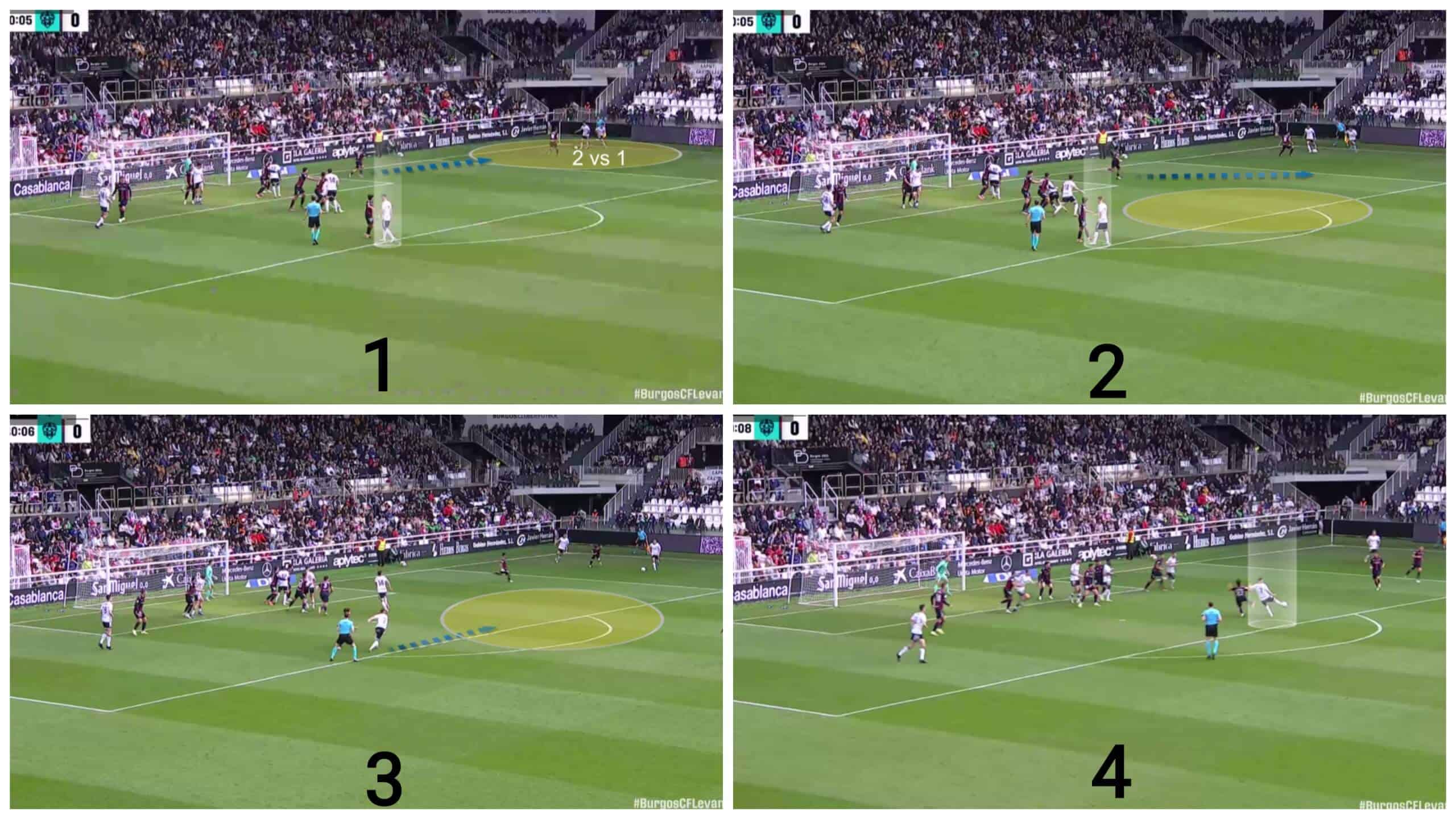
But the ball hits the defenders, as shown below, and here we should suggest that runners should have run to the far post when the routine began to drag the markers with them, opening a shooting lane for the targeted player. To achieve more and more efficiency, we suggest caring more about details; this is the fine margin between a good routine and a high-level one.

They used the same strategy in a different way, asking the rebound player to still stand away, dragging the rebound defender for him, highlighted in white. This gave the taker the opportunity to dribble more and more inside to shoot, as shown in the two first photos.
In the third photo, they add another trick, which is asking the rebound player to go to the far post to make sure that the rebound defender will go with him, leaving the targeted area empty while also being a probable target on the far post if the taker couldn’t dribble more inside. To be safe, they asked a player inside the box, highlighted in green, to go back to cover. In the fourth photo, the plan works, so the taker can go more and more inside the box to shoot, but the ball goes above the crossbar.
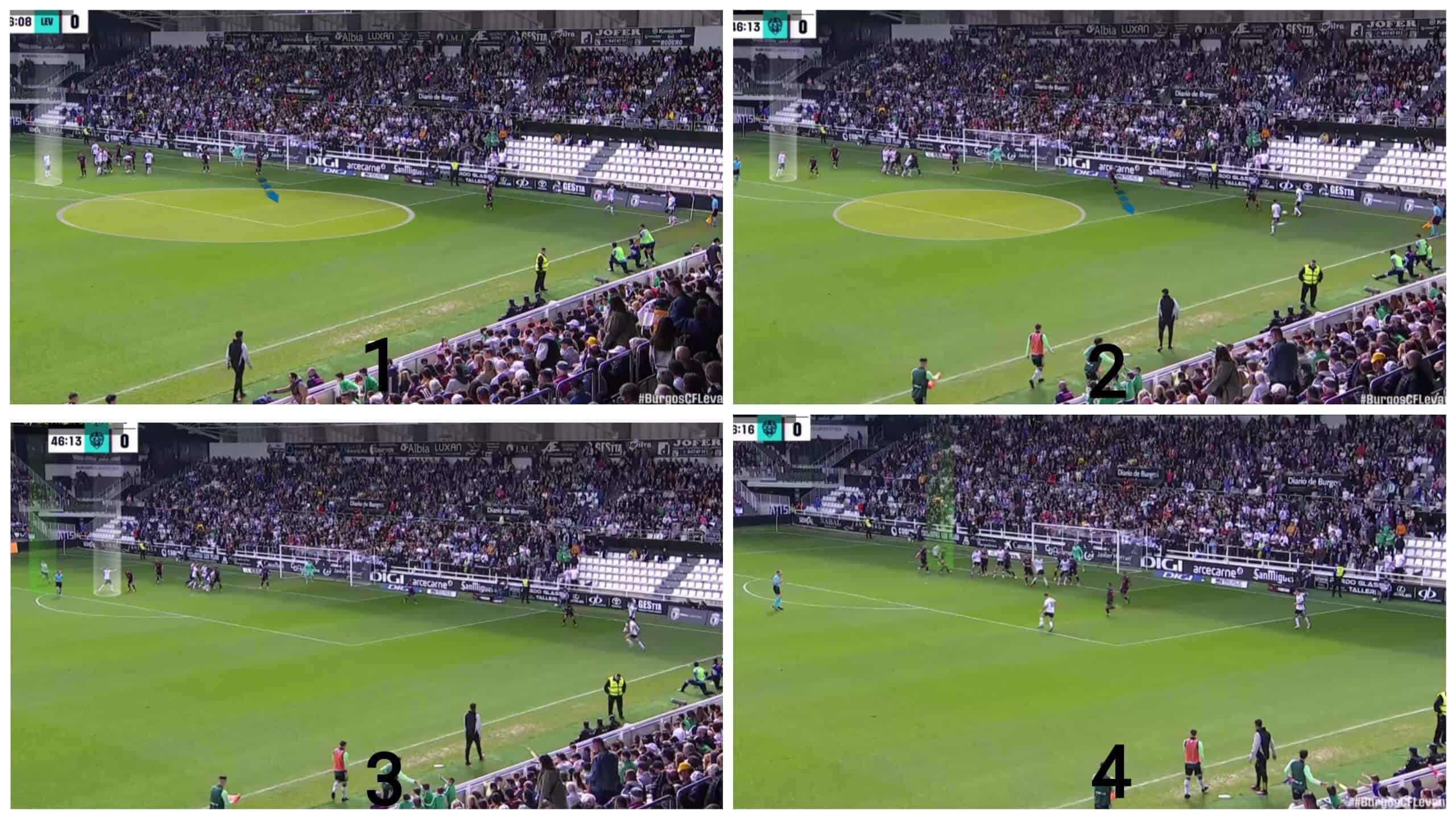
Traffic inside the six-yard
The second general idea they use is exploiting traffic inside the six-yard line to cause many different problems for the opponents. They use this strategy to target the near post, the far post, and the rebound zone, which makes them unexpected. Let’s start with targeting the near post.
In the first photo below, it is clear that the opponent defends with three zonal defenders, five man markers, a short-option defender and a rebound defender. In the second photo, the routine begins while the targeted player stands on the line, blocking his marker and preventing him from going higher. The other five players are separated into two groups: The first group, three players, goes to the area before the near post to drag the first zonal defenders and their markers too, while the second group, two players, goes to the far post to receive any probable flicked pass, as shown in the third photo.
In the third photo, to target the space behind him, between the first and the second zonal defenders, he waits for the right moment after all of that has happened to push his marker and step back. In the fourth photo, the plan works, so the goalkeeper is forced to go to claim the ball.
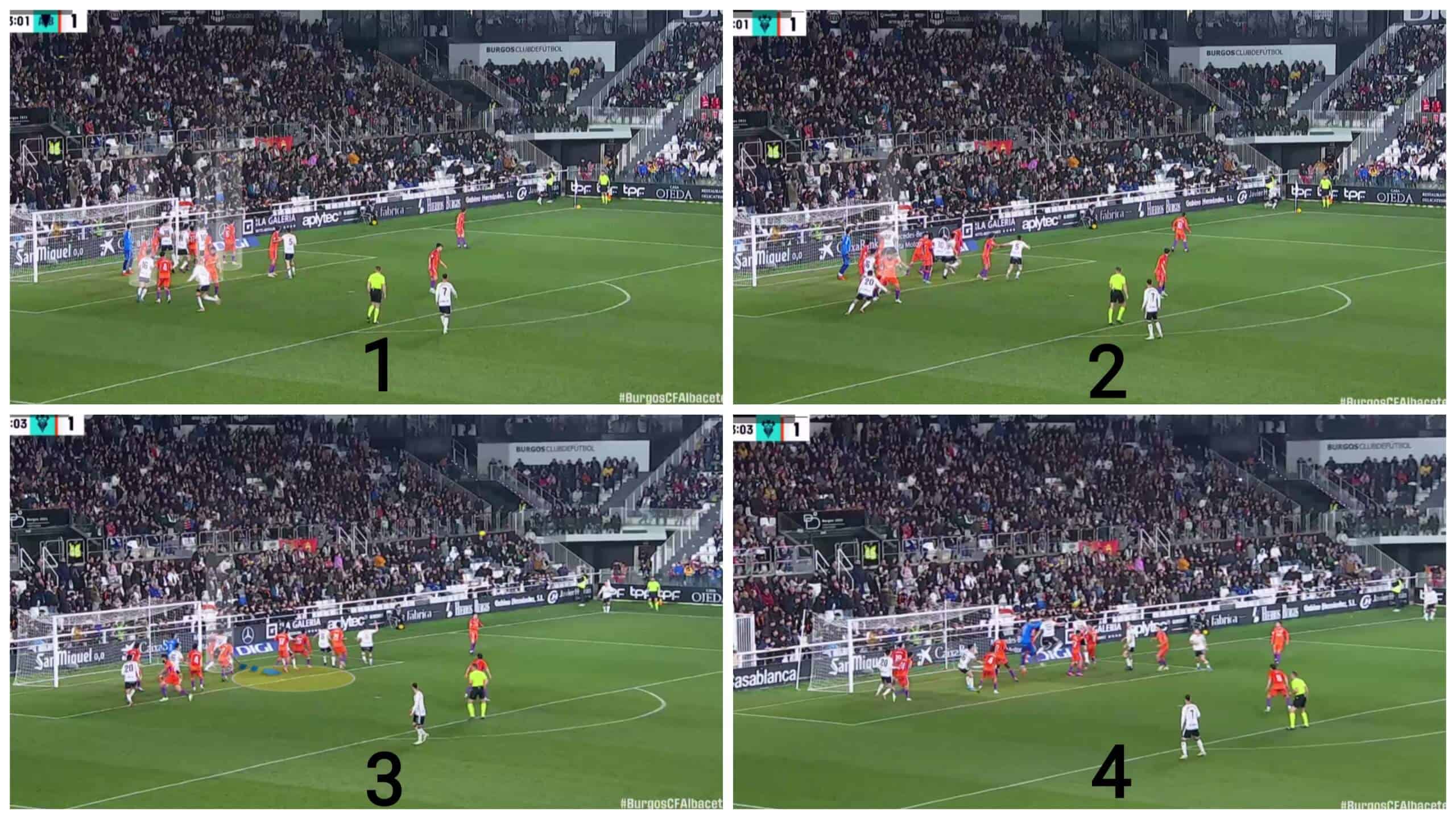
But he can’t punch the ball away, so it lands in front of the targeted player who kicked it into the net, as shown below.

As mentioned above, they can also target the far post with the same general idea, but they cause other problems for the defenders in this case. Let’s discover how!
In the first photo, the opponent defends with three zonal defenders, six man markers and a rebound defender who is the only defender outside the six-yard while the targeted player stands on the line after the far post, as shown in the second photo. In the third photo, he fakes a movement toward the outside to force the defender to turn around, giving his back to the ball, which causes an orientation problem for him because he can’t keep tracking the ball and the attacker at the same time. In the fourth photo, the targeted player starts to move to the targeted area when the ball is in the air, so the defender is forced to look up to see the ball losing communication with the attacker, and at this moment, the attacker leads the situation standing at the defender’s back.
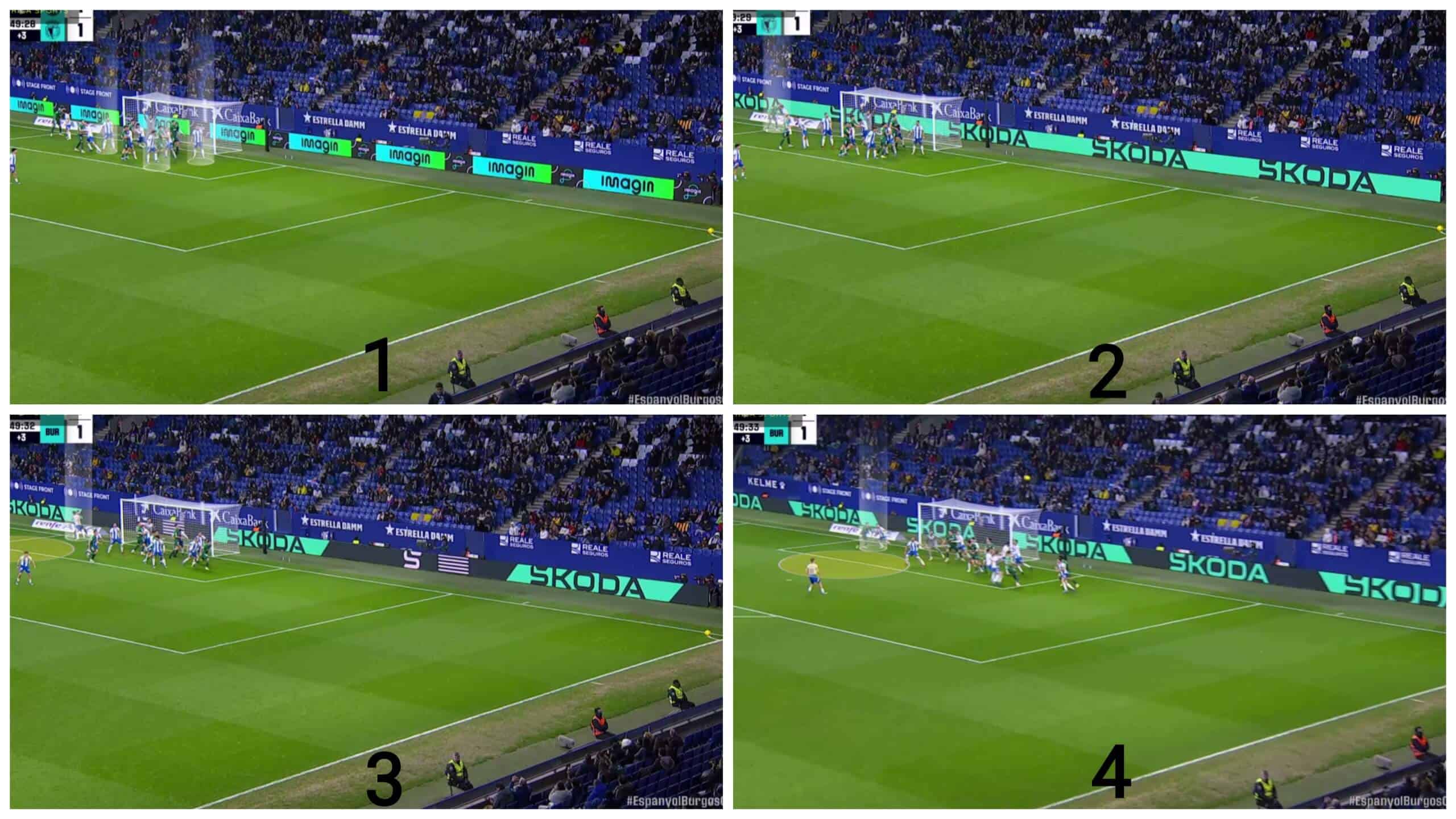
The plan works, and you can see clearly below the positional superiority of the attacker who puts the ball into the net at the end.

They can also use this strategy in another way: targeting the rebound area for a rebound shot.
Making most of the attackers inside the six-yard means that the markers will go with them, leaving all the space between the six-yard and the rebound zone empty, which forces the rebound defender to go more inside the box, as shown in the first photo below. In the second photo, the rebound attacker drags the rebound defender with him for a coming attacker from the back, exploiting that most of the defenders stand in the six-yard, so they cut a long way to press him, as shown in the third photo.
In the fourth photo, the plan works, exploiting the excellent shooter who can score a goal from that distance, putting the ball in the far angle of the goal.
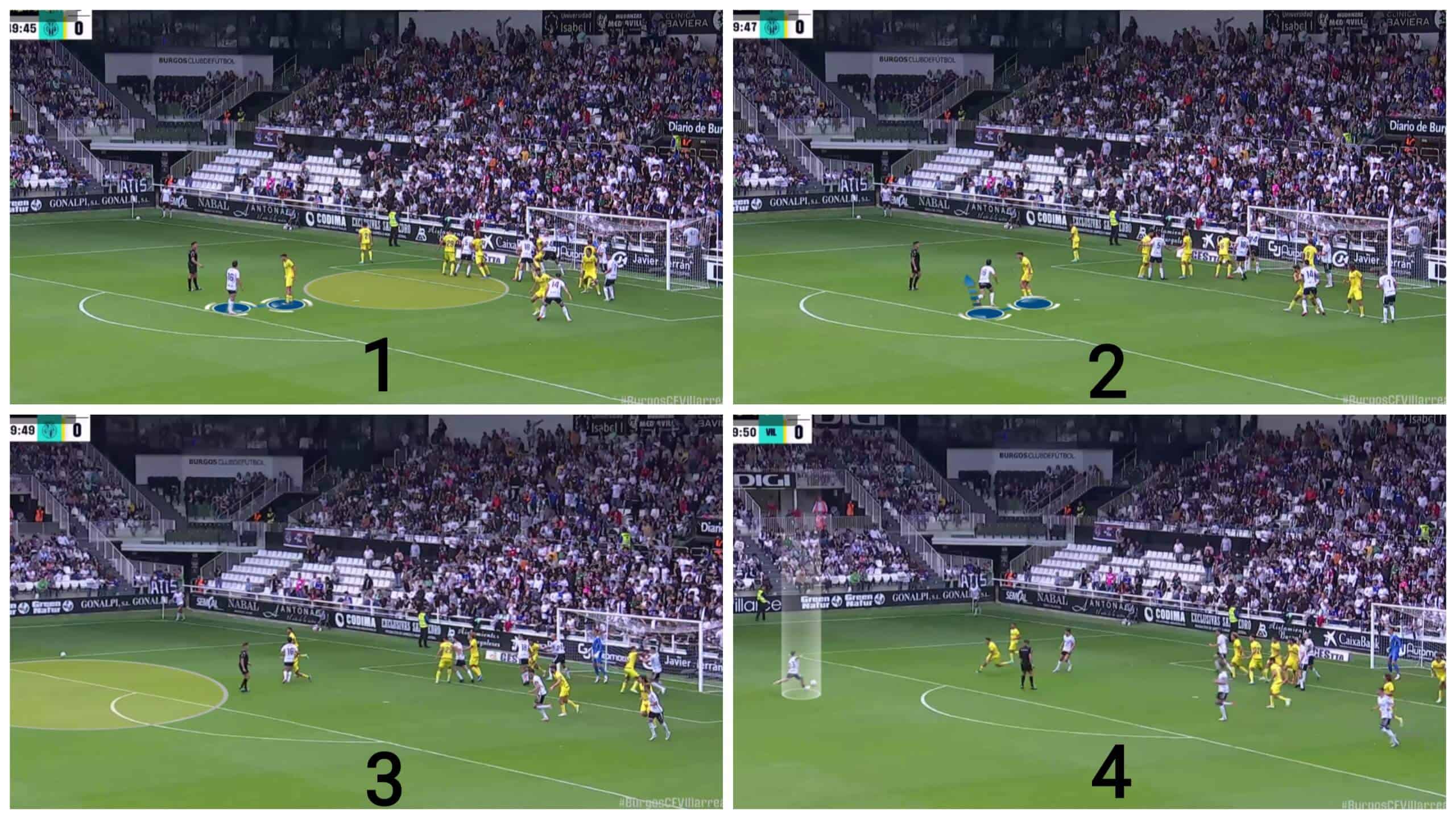
The result is a goal, as shown below.

As an opposite idea, they often target the area between the six-yard and the rebound defender, as we will explain below.
In the first photo below, the same problem appears: a huge area is uncovered because of the traffic inside the six-yard, so the rebound defender stands more inside the box. In the second photo, the routine begins by using a hybrid idea between the short-corner idea and the traffic idea we talked about, so they asked an attacker to come suddenly toward the taker, acting that he would receive the ball and pass it back to him, as shown in the third photo below, but he has a different role to passes the ball directly with a small touch toward the uncovered area, we have talked about, for the rebound attacker who suddenly attacks it exploiting that the rebound defender is busy with tracking the ball thinking that it would come again for the taker.
In the fourth photo, the plan works, and we should mention that they have implemented its idea many times.
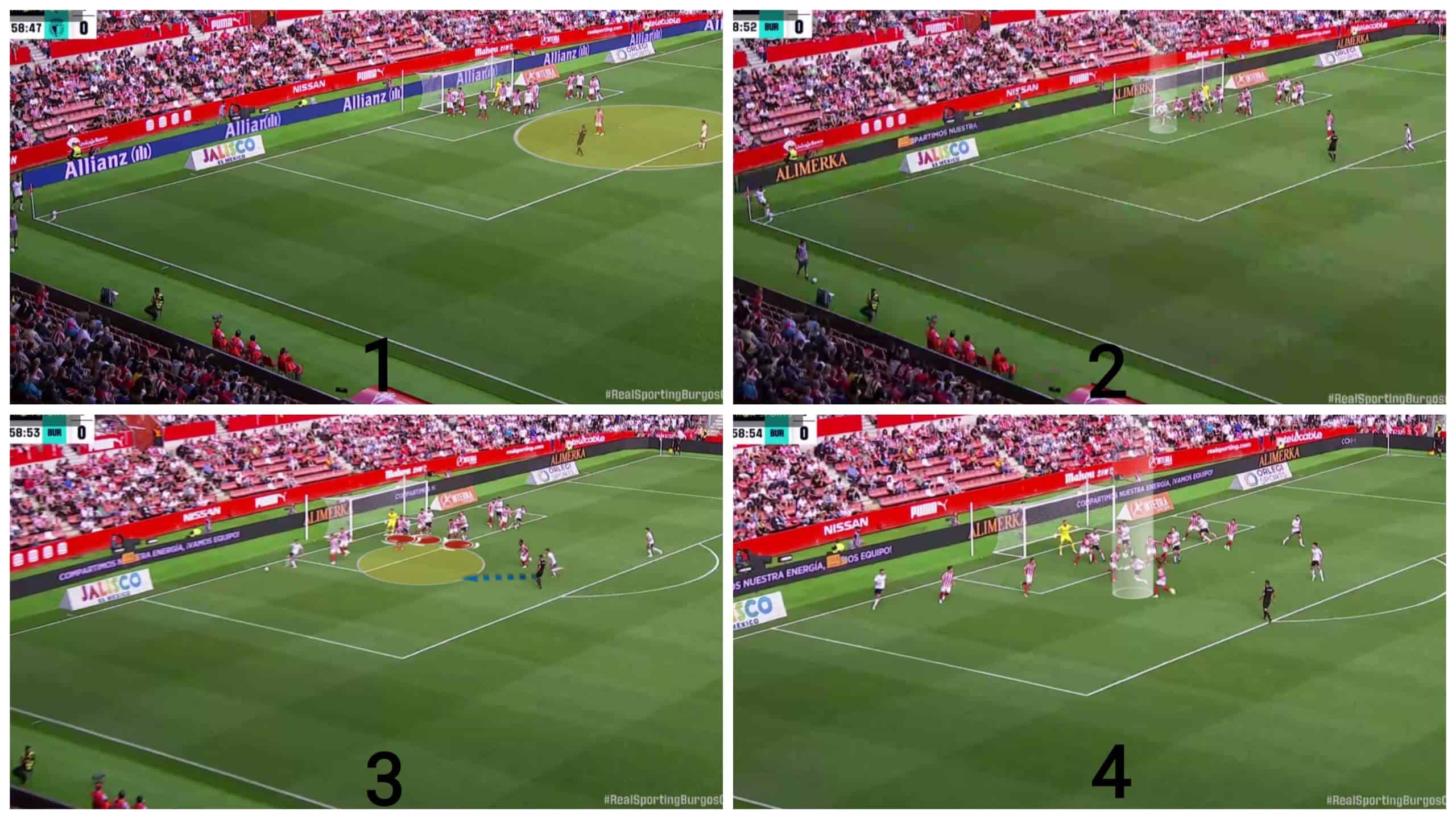
The result is a goal, as shown below.

Conclusion
In this analysis, we have discussed the reasons behind Burgos’ superiority in offensive corner kicks and the extent of the impact and effectiveness of these ideas despite their simplicity and repetition.
In the set-piece analysis, we have discussed their numerous and diverse ideas, which revolve around two main concepts: The first one is exploiting short corner kicks, which encompasses several ideas within them, including shooting and crossing, while the second one is creating traffic within the six-yard box, which can be exploited to target the near or far post or even the rebound area.






Comments